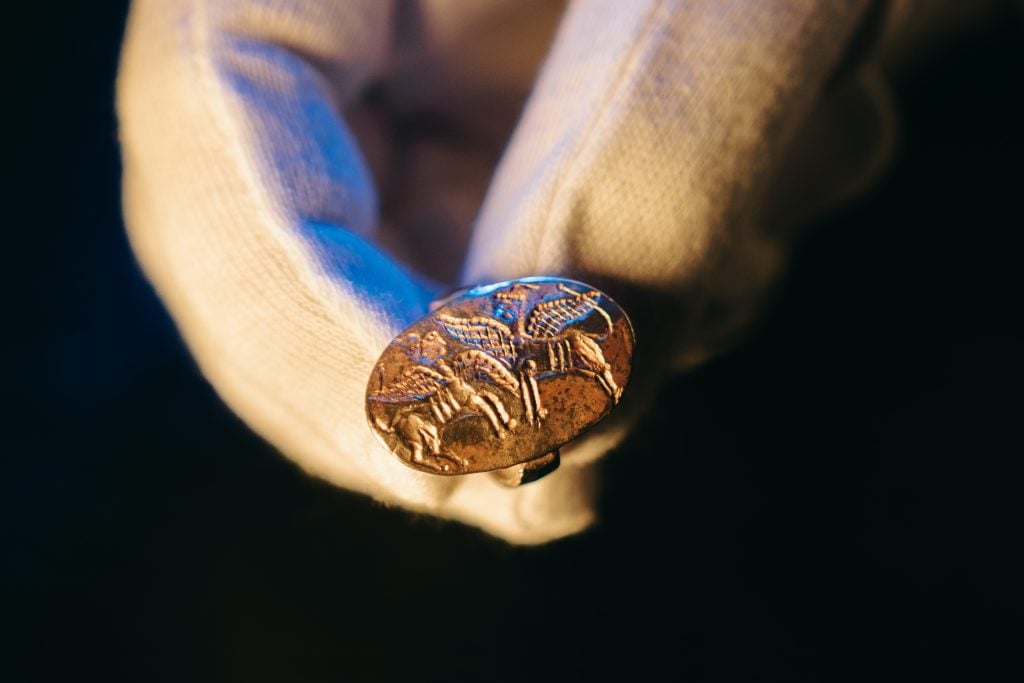At a ceremony on Thursday, 19 May, the Nobel Foundation returned a Mycenaean gold ring to a delegation from Greece’s Ministry of Culture and Sports. During the Second World War, many artefacts were stolen from the Archaeological Museum of Rhodes, one of which was the Mycenaean gold ring. The ring was later bought by Nobel Prize laureate Georg von Békésy in the United States. After the laureate’s death in the 1970s, his extensive art collection was donated to the Nobel Foundation.
“To us, it was obvious that the ring should be returned. This artefact is of very great cultural-historical value for Greece,” says Vidar Helgesen, Executive Director of the Nobel Foundation, who handed over the ring.
Elena Vlachogianni works with documentation and protection of cultural goods at Greece’s Ministry of Culture and Sports. She attended the ceremony and received the ring.
“We receive today with unspeakable joy and deep emotion the gold Mycenaean ring to return it to Greece and especially to the Archaeological Museum of Rhodes,” she says.

Dr Lina Mendoni, Minister of Culture and Sports of Greece, made a statement prior to the ceremony: “The Nobel Foundation and Sweden show a token of respect to modern day Greece and to the ongoing efforts we make in order to combat the illicit trafficking of antiquities. We are grateful for this generous gesture, an example that should be followed by institutions that hold treasures.”
Andreas Fryganas, Ambassador of Greece to Sweden, also participated in the ceremony and called the stance of the Nobel Foundation and the Mediterranean Museum a beacon of morality in matters of return of cultural property.
Georg von Békésy was awarded the Nobel Prize in Physiology or Medicine in 1961 for his research on the function of the cochlea in mammalian hearing organs. In addition to his commitment to science, von Békésy had a strong interest in art. Over the years, he built up an extensive art collection. At his death in 1972, his entire collection was bequeathed to the Nobel Foundation. Most of these artefacts have since been kept at the Museum of Mediterranean and Near Eastern Antiquities, the Museum of Far Eastern Antiquities and the Museum of Ethnography in Stockholm.
One of the artefacts in Georg von Békésy’s collection was a Mycenaean (late Bronze Age) gold ring dated to around 1200 BC. The ring was found in 1927 during an excavation of a burial ground on the Greek island of Rhodes led by the Italian archaeologist Giulio Jacopi. It bears a representation of two confronted sphinxes on its oval bezel. In grave 61, there were also other grave gifts such as pots, bronze mirrors and several rings. During World War II, many artefacts were stolen from the Archaeological Museum of Rhodes, one of which was the Mycenaean gold ring. The ring was later bought by Nobel Prize laureate Georg von Békésy in the US.
Careful research has been done to ensure the authenticity of the gold ring. Representatives from the Nobel Foundation, Greece’s Ministry of Culture and Sports, the Embassy of Greece in Stockholm, the Museum of Mediterranean and Near Eastern Antiquities and the Swedish Ministry of Culture were present at the ceremony at the Nobel Foundation in Stockholm.
